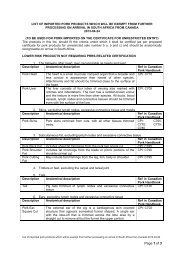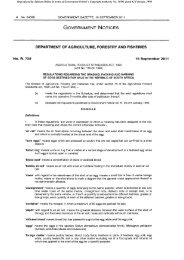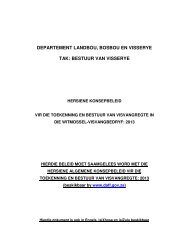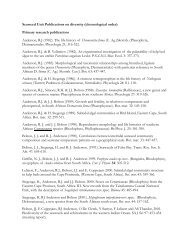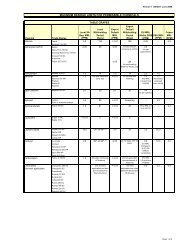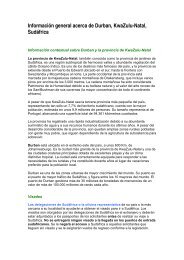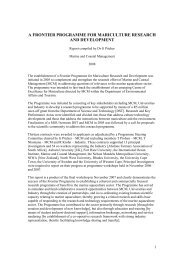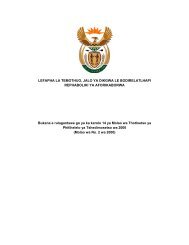Create successful ePaper yourself
Turn your PDF publications into a flip-book with our unique Google optimized e-Paper software.
C<br />
hitons or armadillos are primitive, oval,<br />
flattened molluscs with eight shell plates<br />
surrounded by a fleshy girdle, which is usually<br />
strengthened and protected by scales, bristles or<br />
spines. The name of the class Polyplacophora liter -<br />
ally means 'many-shell-bearer'. When the end<br />
shells wash up on the beach they look like tiny sets<br />
of false teeth. The chiton’s body is bilaterally sym -<br />
metrical with a mouth at the front end, a long<br />
coiled gut and a posterior anus. The muscular foot<br />
attaches it firmly to rocks and is surrounded by a<br />
rim of gills. The eight shell plates enable the chiton<br />
to bend to fit the shape of the rock. It does not cling<br />
by suction but has a thin layer of slime that allows<br />
adhesion and movement. Anyone who has tried to<br />
pull apart two sheets of glass with a thin layer of<br />
water between will understand the power of this<br />
force of adhesion. On the other hand the two sheets<br />
can easily slide on one another and in this way the<br />
chiton glides along on a slime trail. When chitons<br />
are detached they can curl into tight balls thus<br />
protecting the soft parts and gills. The head is<br />
completely hidden beneath the girdle and lacks<br />
eyes and sensory tentacles. Chitons are unusual in<br />
that they have lots of little eyes with tiny lenses<br />
peeping through the shells on top of the animal.<br />
shells<br />
girdle<br />
Brooding chiton<br />
with young<br />
C O A S TA L A N D M A R I N E L I F E – A N I M A L S : I N V E RT E B R A T E S – M O L L U S C S<br />
Chitons 3B<br />
Tulip chiton<br />
Feeding<br />
Chitons are grazers that rasp algae from the rocks. In common<br />
with almost all molluscs, chitons possess a radular – a long<br />
tongue with rows of tiny teeth – that is projected from the<br />
mouth to scrape up food. They usually hide under rocks and<br />
many of them emerge at night to feed. They have a very long<br />
gut to enable them to digest their tough food. They also store<br />
the faeces until the tide rises and can flush the faeces away.<br />
Reproduction and life cycle<br />
Chitons reproduce by external fertilisation, shedding vast<br />
quantities of eggs and sperm into the sea. Fertilised eggs<br />
develop into trochophore larvae that look like tiny spinning<br />
tops. The brooding chiton, Chiton nigrovirescens retains the<br />
eggs under the girdle where they develop into fully formed<br />
juveniles, which can easily be seen if the chiton is prised off<br />
the rocks and turned over.<br />
Distribution<br />
T h e re are 26 southern African species, most of which are found<br />
intertidally or down to depths of 10 m. The girdle around the<br />
shells (valves) is a useful feature for identification as it contains<br />
scales and spines that are diagnostic for each species. Most<br />
of the species of chiton occur along the south coast with only<br />
three common species on the east coast and four on the<br />
west coast.<br />
EXAMPLES OF CHITONS<br />
Chitons with a scaly girdles<br />
Tulip chiton Chiton tulipa<br />
The attractive tulip chiton is pale pink with zigzag patterns of<br />
brown and reddish spots and streaks on the shell. The girdle<br />
is also striped and covered with large overlapping scales.<br />
Textile chiton Ischnochiton textilis<br />
This pale yellow or grey chiton is widespread around the<br />
coast, under boulders in rock pools. Its girdle is covered with<br />
small oval scales with many ridges. The smaller dwarf chiton<br />
Ischnochiton oniscus is pale or dark. It is usually about<br />
10 mm long and occurs under rocks in sandy areas.<br />
Brooding chiton Chiton nigrovirescens<br />
The brooding chiton is brownish-black with large coppery-<br />
brown scales covering the girdle. It usually clusters in groups<br />
under rocks. The eggs are brooded under the girdle and it<br />
does not have a planktonic larva.





